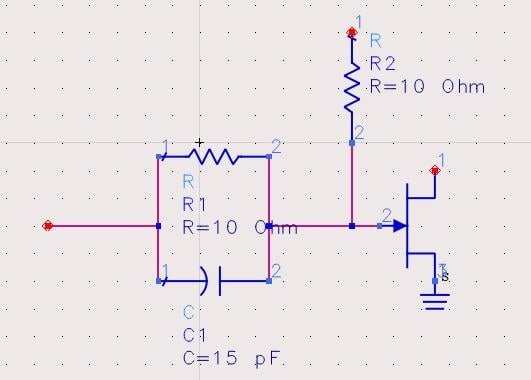-
 Aparna Bhuvanagiri
0Hi,
Aparna Bhuvanagiri
0Hi,
I'm designing a 100 W amplifier using BLF647P for the frequency range of 512- 1250 MHZ. I'm using ADS for my design.
According to the datasheet, The device is suitable for HF-1500 MHZ frequencies. I've simulated and plotted stability factor and stability measurement for the frequency range of 100 MHz to 3 GHz and found out that the device is unstable at frequencies around 2 - 2.5 GHz which is beyond the required range and device range.
Does this instability affect my amplifier and oscillate it even though it's not in my required frequency band?
Do I need to take any measures while designing matching network?
-
 Osman CeylanAccepted Answer
0Hi Aparna,
Osman CeylanAccepted Answer
0Hi Aparna,
That transistor is conditionally stable. It can oscillate. Therefore you have to consider it during matching network design. Since the gain of the device is not very high at that region, it is not difficult to make your amplifier almost unconditionally stable.
You need to check the stability factor with input and output matching network.
You can see this article: https://www.researchgate.net/publication/325101221_Refine_biasing_networks_for_high_PA_low-frequency_stability
Osman -
 Aparna Bhuvanagiri
0Hi Osman,
Aparna Bhuvanagiri
0Hi Osman,
I've seen the article. It's about stabilizing at low frequencies by carefully biasing. Can I apply this concept at higher frequencies? Here for my case at 2 GHz? -
 Aparna Bhuvanagiri
0Hi Osman,
Aparna Bhuvanagiri
0Hi Osman,
I've seen the article. It's about stabilizing at low frequencies by carefully biasing. Can I apply this concept at higher frequencies? Here for my case at 2 GHz? -
 Osman Ceylan
0For higher frequency, you can use R//C type network. I attached an example. You need to find suitable values which is not degrading the gain depending on your operating frequency.Attachment
Osman Ceylan
0For higher frequency, you can use R//C type network. I attached an example. You need to find suitable values which is not degrading the gain depending on your operating frequency.Attachment biasing
(30K)
biasing
(30K)

-
 Aparna Bhuvanagiri
0Also for push pull (balanced) type amplifier is stability analysis wrt one Fet enough?
Aparna Bhuvanagiri
0Also for push pull (balanced) type amplifier is stability analysis wrt one Fet enough? -
 Osman Ceylan
0This is a kind of initial check for the transistor. If you do load-pull simulations, it is enough. After designing matching networks, it is necessary to check the stability of all circuit. Matching networks can create undesired resonances at out of operation band which can cause oscillation.
Osman Ceylan
0This is a kind of initial check for the transistor. If you do load-pull simulations, it is enough. After designing matching networks, it is necessary to check the stability of all circuit. Matching networks can create undesired resonances at out of operation band which can cause oscillation. -
 Aparna Bhuvanagiri
0I'm replying after a year. I have followed your suggestion. Used conical inductor for DC feed (since wide band application) and used series R and parallel R-C network for making the device unconditionally stable. This have solved my stability problem and Amplifier is working as expected. Thank you so much for your suggestion and insight. :smile:
Aparna Bhuvanagiri
0I'm replying after a year. I have followed your suggestion. Used conical inductor for DC feed (since wide band application) and used series R and parallel R-C network for making the device unconditionally stable. This have solved my stability problem and Amplifier is working as expected. Thank you so much for your suggestion and insight. :smile:
Welcome!
Join the international conversation on a broad range of microwave and RF topics. Learn about the latest developments in our industry, post questions for your peers to answer, and weigh in with some answers if you can!
Categories
- About Our Site
- Antennas
- Applications
- Biological Effects and Applications
- Calculators
- Communications
- Computer Aided Design
- EDA Software
- Emerging Applications and Technology
- Employment
- Field Theory
- Filters and Passives
- General Questions
- High Power
- History
- MMIC and RFIC
- Packaging and Materials
- Radar
- Sources and Receivers
- Test and Measurement
More Discussions
- Terms of Service
- Useful Hints and Tips
- Sign In
- © 2025 Microwaves 101 Discussion Board



